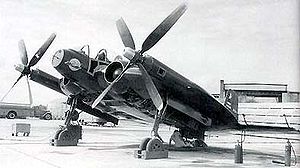Vought XF5U Flying Flapjack Video - Historical Overview
|
|

Picture - The XF5U-1 during testing
Role: Fighter
Manufacturer: Vought
Designed by: Charles H. Zimmerman
Status: Cancelled 17 March 1947
Primary user: United States Navy
Number built: 2
Developed from: Vought V-173
The Vought XF5U "Flying Flapjack" was an experimental U.S. Navy fighter aircraft designed by Charles H. Zimmerman during World War II. This unorthodox design consisted of a flat, somewhat disc shaped body (hence its name) serving as the lifting surface. Two piston engines buried in the body drove propellers located on the leading edge at the wingtips.
Design and development
A developed version of the original V-173 prototype, the XF5U-1 was a larger aircraft. Of all-metal construction, it was almost five times heavier, with two 1,600 hp (1,193 kW) Pratt & Whitney R-2000 radial engines. The configuration was designed to create a low aspect ratio aircraft with low takeoff and landing speeds but high top speed.
The XF5U looks like it should not be able to fly, as its wing area looks so small. Normally, a wing with such a low aspect ratio will suffer from very poor performance due to the degree of induced drag created at the wingtips, as the higher pressure air below spills around the wingtip to the lower-pressure region above. In a conventional aircraft, these wingtip vortices carry a lot of energy with them and hence create drag. The usual approach to reducing these vortices is to build a wing with a high aspect ratio, i.e. one that is long and narrow. However, such wings compromise the maneuverability and roll rate of the aircraft, or present a structural challenge in building them stiff enough. The XF5U overcomes the tip vortex problem using the propellers to actively cancel the drag-causing tip vortices. The propellers are arranged to rotate in the opposite direction to the tip vortices, which retains the higher-pressure air below the wing. Since this source of drag is eliminated, the aircraft will fly with a much smaller wing area, and the small wing yields high maneuverability with greater structural strength.
The propellers envisioned for the completed fighter were to have a built-in cyclic movement like a helicopter's main rotor, with a very limited ability to tilt up and down to aid the aircraft in maneuvering. An ejection seat was fitted to allow the pilot to clear the massive propellers in the event of an in-flight emergency. Although the prototype was unarmed, a combination of machine guns and cannons would have been installed under the nose.
Testing and evaluation
The XF5U design was promising: specifications given at the time promised the ability to hover like a helicopter while having an airspeed range of 0 to 550 mph (885 km/h). However, it came at the time when the United States Navy was switching from propeller driven to jet propelled aircraft. By 1946, the XF5U-1 project was already long over its expected development time, and well over budget. With jet aircraft coming into service the Navy finally canceled the project on 17 March 1947 and the prototype aircraft (V-173) was transferred to the Smithsonian Museum for display. Although two aircraft were constructed, a lone XF5U-1 underwent ground runs but never overcame vibration problems. Taxi trials at Vought's Connecticut factory culminated in short "hops" that were not considered true flights. The only completed XF5U-1 proved to be so structurally solid that it had to be destroyed by a wrecking ball.
Specifications (XF5U-1)
General characteristics
Crew: One, pilot
Length: 28 ft 7 in (8.73 m)
Wingspan: 32 ft 6 in (9.91 m)
Height: 14 ft 9 in (4.50 m)
Wing area: 475 ft² (44.2 m²)
Empty weight: 13,107 lb (5,958 kg)
Loaded weight: 16,722 lb (7,600 kg)
Max takeoff weight: 18,772 lb (8,533 kg)
Powerplant: 2x— Pratt & Whitney R-2000-7 radial engine, 1,350 hp (1,007 kW each) each
Performance
Maximum speed: 413 knots / 475 mph at 28,000 ft (estimated) (765 km/h at 8,534 meters)
Range: 1,064 miles (1,703 km)
Service ceiling: 34,492 ft (10,516 m)
Rate of climb: 3,000 ft/min (914 m/min)
Wing loading: 35 lb/ft² (172 kg/m²)
Power/mass: 0.16 hp/lb (0.27 kW/kg)
Armament
6 x— .50 machine guns or 4 x— 20 mm cannon
2 x— 1000 lb. bombs
Related development
Vought V-173
Bibliography
Chant, Christopher. Fantastic Aircraft. New York: Gallery Books, 1984. ISBN 0-8317-3-189-3.
Ginter, Steve. Chance Vought V-173 and XF5U-1 Flying Pancakes (Naval Fighters Number Twenty-one). Simi Valley, CA: Steve Ginter Publishing, 1992. ISBN 0-942612-21-3.
Guyton, Boone and Paul Marcus. "The Ups and Downs of The Flying Pancake." True, July 1951. Vol. 29, no. 170.
Jerram, Michael E. Incredible Flying machines: An Anthology of Eccentric Aircraft. New York: Exeter Books, 1980. ISBN 0-85685-835-8.
Norton, Bill. U.S. Experimental & Prototype Aircraft Projects: Fighters 1939-1945. North Branch, Minnesota: Specialty Press, 2008, pp. 165-168. ISBN 978-1-58007-109-3.
XF5U Standard Aircraft Characteristics. Washington, DC: Naval Historical Center at the U.S. Navy Yard. Retrieved: 25 July 2009.
Winchester, Jim. "Vought XF5U-1". Concept Aircraft: Prototypes, X-Planes and Experimental Aircraft. Kent, UK: Grange Books plc., 2005. ISBN 1-84013-309-2.
Winchester, Jim. "Vought V-173 and XF5U-1 'Flapjack' (1942)". X-Planes and Prototypes. London: Amber Books Ltd., 2005. ISBN 1-904687-40-7.
Living Warbirds: The best warbirds DVD series.
Source: WikiPedia